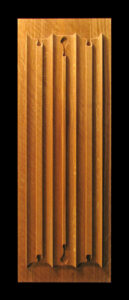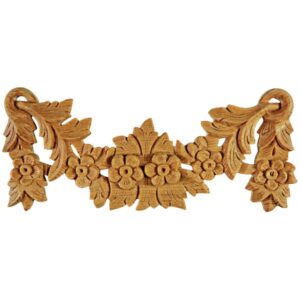
The Ultimate Guide to Wood Onlays and Appliques and How to Use them
Wood onlays provide a key element of decoration for traditional style furniture and architecture.
Take an in-depth look at these respected decorative components. Become familiar with our furniture decals and architectural embellishments that are so valuable to prestige design.
From the definition of wood onlays and their design development throughout history, to modern decorative uses, including fireplace mantles, we’ll illustrate everything you need to know.
What are Wood Onlays and Furniture Appliques?
Wood onlays and furniture appliques are decorative elements that add a touch of elegance and sophistication to furniture. They revitalise your home décor or unique architectural project in a classical style. Use these ornamental pieces to enhance the appearance of cabinets, fire surrounds, interior décor and architectural projects.
In this overview, we’ll explore the different types of wooden embellishments, furniture overlays and architectural decoratives that provide timeless decorating ideas. We will show you how to use them effectively to enhance your interior joinery.
What are the Origins of Decorative Wood Design?
Decorative wood onlays provide core embellishment in a simple form. Apply them with eye catching effect to enhance joinery and other materials in various styles.
One of the earliest examples of decorative wood carving in furniture dates from the Medieval practice of splitting cut timber down the grain. This was a labour-saving technique, when actually sawing a panel from a wide tree trunk would have been both laborious and challenging, given the tools available at the time. In doing so, the woodworker would have simply hammered a wedge into the natural splits or shakes in the wood to split it lengthways. This produced what was called riven oak. Its disadvantage was that it left an uneven, raised surface, where the fibres of the wood had been split or riven apart. It became customary to camouflage this apparent roughness by disguising it with a linenfold effect.

Simply smoothing off the edges of the raised grain, to give the effect of folded cloth, led to this early example of decorative wood carving, called linenfold.
Stylisation of decorative wood carving became more refined in the colonial era. The sophisticated influence of arabesque swirls and curls in the Moghul art of India and the classical treasures of ancient Egypt, became commonplace terms of reference for cabinetmakers and architects. Creating what we have come to know as Regency, Georgian and Victorian house and furniture design.
 A classical Victorian house interior
A classical Victorian house interior
More recently, classical applied carvings have in turn borrowed from these influences to create the hybrid styles of ‘vintage farmhouse’, ‘country style’ and ‘rustic chic’.
Eclectic Steampunk is a fusion of designs from these eras, sometimes labelled as retrofuturistic.
Maximalism is a contemporary design style rooted in a ‘more is more’ philosophy. Blending decorative relief onlays with compelling colours, patterns, textures, forms and ‘objets d’art’, Maximalism is big and bold.
What Different Types of Decorative Onlays and Furniture Appliques are There?
1. Wood Carvings: Attach intricately carved wooden pieces to furniture to create a decorative effect.
2. Resin Appliques: Mimic the look of wood carvings with lightweight and affordable decorative elements.
3. Embossed Wood Appliques: These are typically made from thin pieces of soft wood and feature raised designs. Stain or paint them to match the furniture.
4. Sculpted stone onlays are ubiquitous on the façade of period prestigious buildings. These can now be reproduced in moulded concrete.
5. Appliques, cast in plaster, are workable for conventional plaster ceilings.
What are Wood Appliques Used for?
Architectural Ornament: Carved wooden friezes, architectural pediment centrepieces, medallions, decorative wall panels and traditional wood emblems and motifs are applied to all manner of architectural joinery to create prestigious designs.
Creative Home Décor: Wooden components are used for joinery in nostalgic wood interiors. Maximalist wood accents use the retro styling of Victoriana, Regency core, Georgian and country chic influences.

A Victorian house interior onlay
Wood Fireplace Embellishment: Decorative Onlays in the Robert Adam style, such as swags, drops, rosettes and Greek urns, recreate a fire surround in the English heritage style, especially when combined with the use of wooden fireplace corbels.

A Robert Adam fireplace from the V&A.
Refurbishment: A definition of an antique is ‘something that has survived being out of fashion.’ When sorting out the restoration of traditional interiors or old furniture you will find that legacy style wood onlays recreate the beauty of those bygone days.
Reproduction antiques: Wooden appliques and swaying scroll onlays bring elegance to nostalgia furniture and revival beds. Retro style decorative wood carving provides the finishing touch to furniture pediments, panelling and bed headboard design.
What Are The Benefits of Using Wood Onlays?
1. Enhance Aesthetics: Wood onlays and appliques can transform plain furniture into custom, high-end pieces.
2. Versatility: They can be used on a variety of furniture pieces, including cabinets, dressers, and tables. Carved wood onlays provide effective architectural ornament. They can be applied to a range of surfaces as well as timber construction schemes.

A reproduction retro style fire surround swag
3. Upstyling interiors that are in need of refurbishment. With a wide range of retro designs available, it is easy to select a wood onlay that reflects and enhances your design style.
4. Adding prestige and value to your interior space.
5. Customization: Onlays and appliques come in a wide range of designs, allowing for customization based on personal style and preferences.
How Can I Add Value to My Property with Wood Onlays?
Aesthetic appeal – Wood appliques provide valuable decorative elements that are immediately available and require no previous experience to install. They will enhance your interior with an upmarket design theme.
Historical significance – Decorative wood onlays are ideal to replace the ornamentation in older buildings. Maintaining decorative detail, in keeping with cultural origin, is an important element in preserving historical character. Decorative wood appliques play a vital part in maintaining the integrity of heritage properties.
How Are Wood Appliques Made?
First the craftsman draws out his design onto carbon copy paper. Next he cuts a blank piece of wood to size and transfers the design from the carbon paper to the wood. Where the designs are fret cut, also called jaliwork, holes are cut in the wood with a fret saw. The carver then selects suitable chisels, and carves the wood to the design.
Which Appliques Should I Choose?
First consider your desired effect, not forgetting the source of natural light. You can decide on one centrepiece and then choose whether to select other carvings to complement it. These can be a pair of embellishment motifs either side or a repeated motif at regular intervals.
Choose your preferred design style.
Measure carefully the place you would like the ornamentation to sit and choose an appropriate size
What Size Are Appliques?
A selection of small furniture onlays, two inches to sixteen inches wide, can be used as detail. Depending on the job, appliques in medium sizes, twelve to twenty five inches long, enrich interior decor. Larger sizes, up to 6 feet long, make a strong architectural statement.
How to Attach and Fix Wood Appliques
1. Surface Preparation: Ensure that the surface of the furniture is clean and free of any dust or debris before attaching the appliques. Wood onlays will have been pre-finished with sanding, but they are fresh from the carver’s hand and may require careful inspection and possibly further sanding.
Craftsman’s Tip – This can be done with a small piece of sandpaper (120 grit) which has been softened by pre use to minimise the distress of sandpapering the delicate edges of the carving. To fit inside any fret carved facets of the carving, the sandpaper can be rolled into a narrow tube.
2. Placement and Alignment: Carefully position the onlays or appliques on the furniture, ensuring that they are aligned symmetrically and centred properly.
3. Adhesive Application: Use a strong adhesive, such as wood glue or epoxy, to firmly attach the onlays or appliques to the furniture. Larger appliques can be held in place, whilst the adhesive is setting, with a panel pin, skew nailed in beside it, to give extra temporary support. The pin should be removed afterwards. Remove any excess adhesive with a sharp blade,
4. Finishing Touches: Once the onlays or appliques are securely attached, finish them with paint or stain to complement the overall design of the furniture piece.
Environmental Protection
Decorative wood onlays are often low profile and use a minimum of wood to create a maximum impression of enrichment and embellishment. With a small actual volume of wood and a sharp chisel, honed to perfection, the hand of a master craftsman creates an eye catching work of decorative art. Onlays and appliques provide a high level of decorative embellishment for a small volume of wood with little wastage, so preserving precious stocks of lumber.
The Advantages of Using Wood Onlays and Appliques
In conclusion, wood onlays and furniture appliques are versatile and decorative elements that can elevate the aesthetic appeal of woodworking projects. Whether you’re a professional woodworker or a DIY enthusiast, incorporating these ornamental pieces can add unique panache and value to your interior décor and furniture creations.







